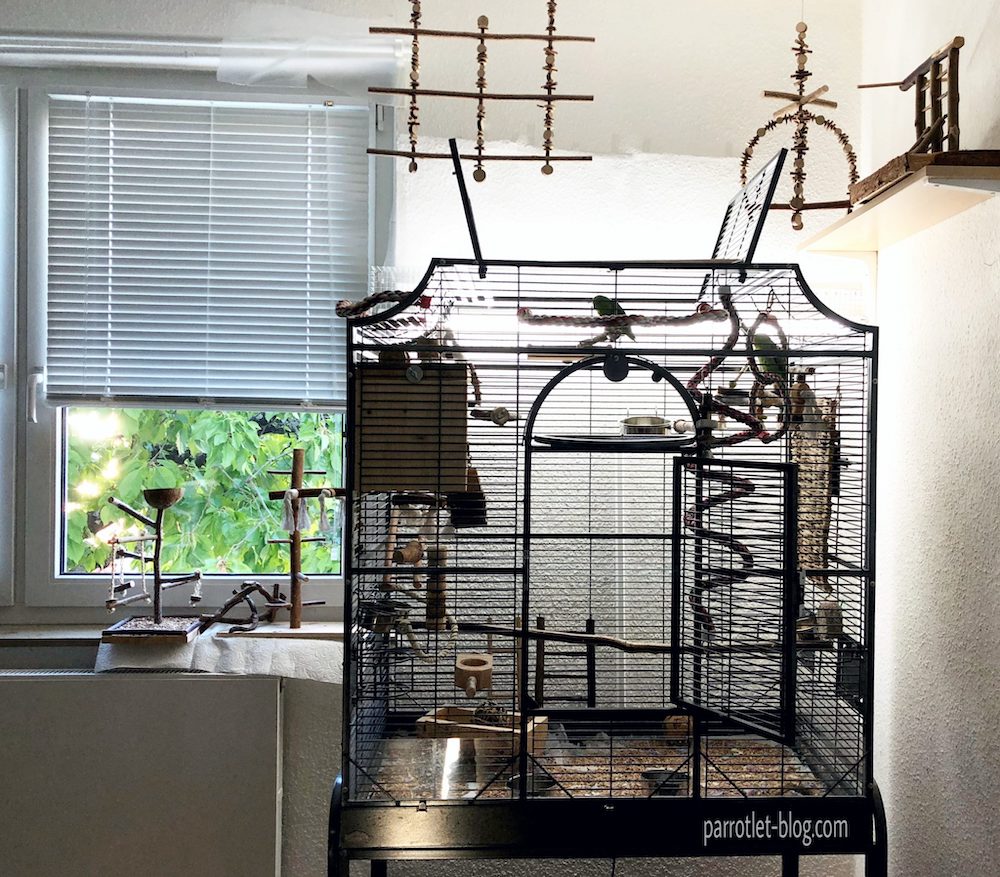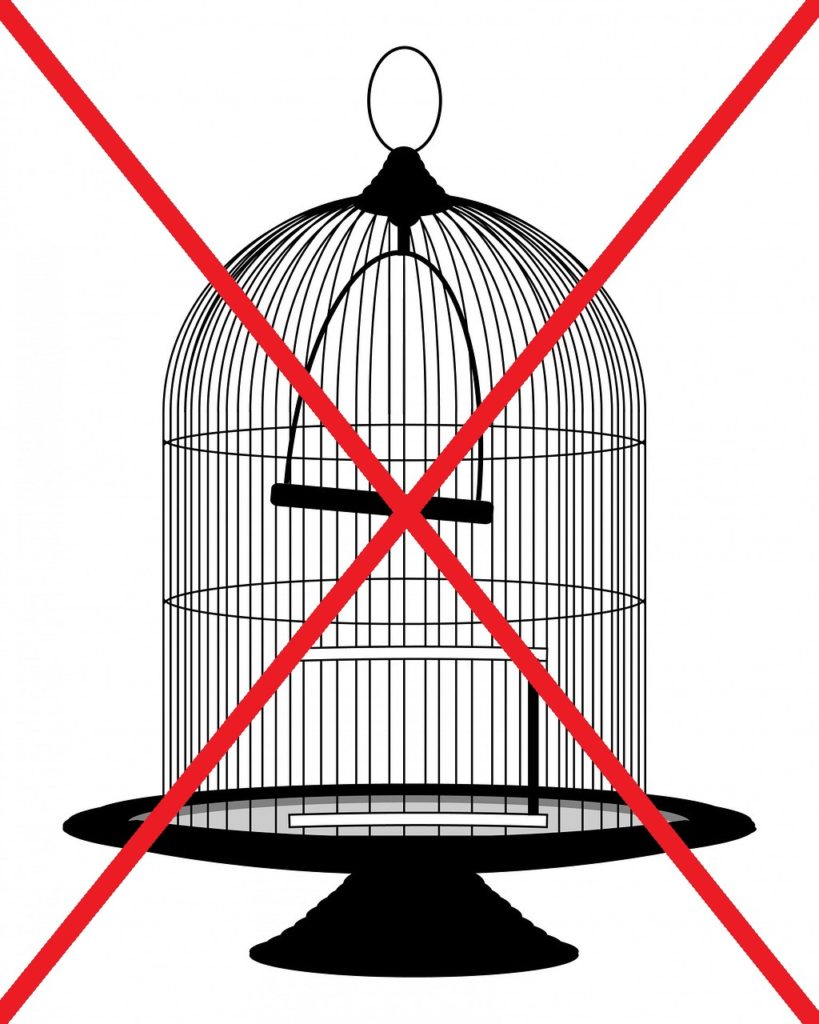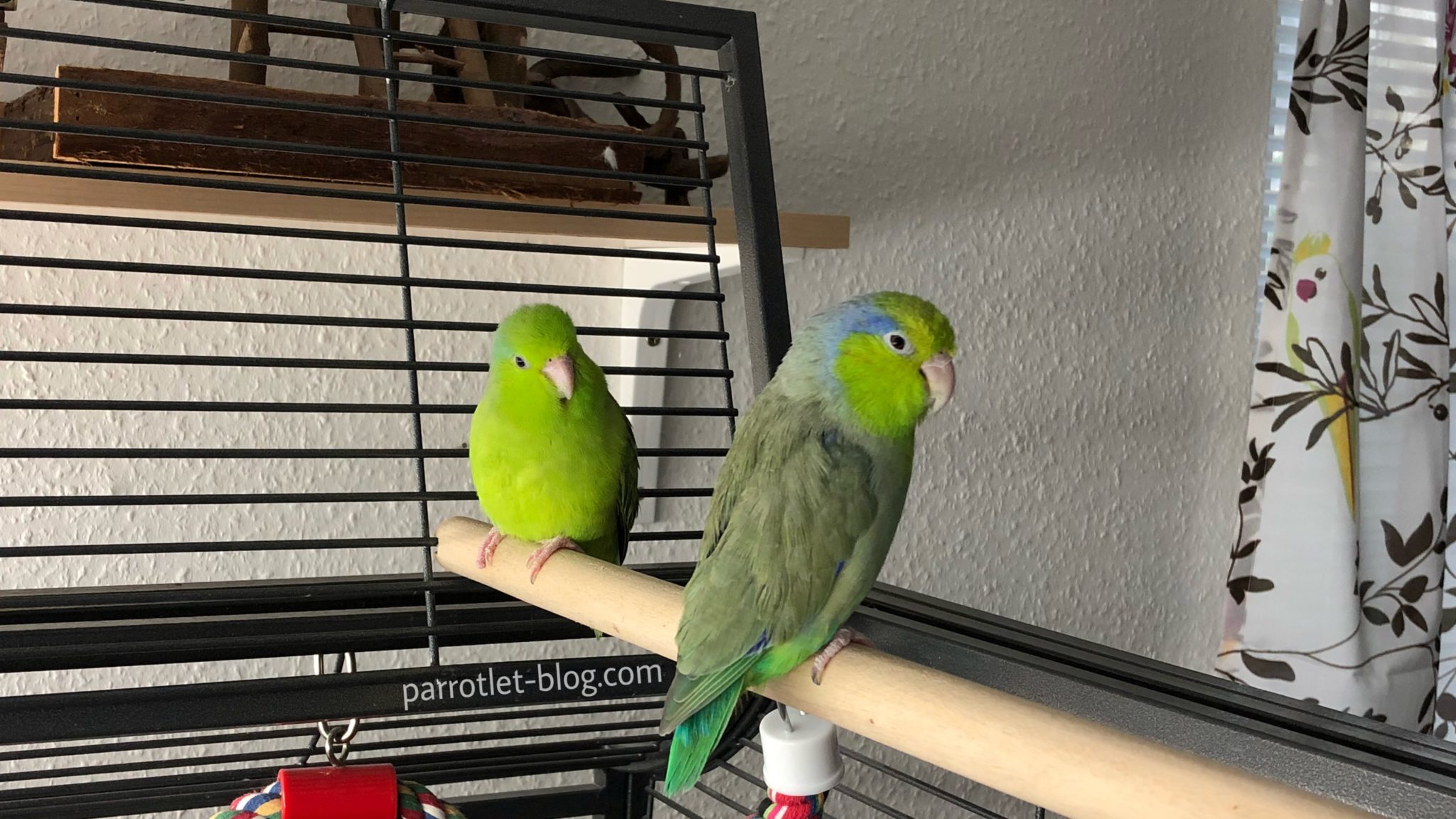The most important thing about a parrotlet cage: There is no “too big”! This means even if parrotlets are very small birds they need a lot of space because they are very territorially.
Parrotlet cage size and shape
Most bird cages that can be bought at pet shops are simply too small for parrotlets. But how should the ideal parrotlet cage look like? Google “birdcage” will kill you from the many different colors, shapes and materials that make up the cages. Please keep in mind that a parrotlet cage should never be bought in appearance, because what looks good is often far from good for parrotlets. The best example of this is the “classic” round birdcage, which just means stress for the birds…
Cage size for two parrotlets
According to the minimum requirements for the keeping of parrots of the Federal Ministry of Food and Agriculture of Germany (Mindestanforderungen an die Haltung von Papageien (10. Januar 1995) des Bundesministerium für Ernährung und Landwirtschaft (BMEL)) a parrotlet cage for one couple should have a minimum size (!) of 40″ (1.0 m) wide x 20″ (0.5 m) high x 20″ (0.5 m) deep. By the way, this recommendation assumes that the birds do not get a free flight in the room… But even with a cage with these minimum sizes, parrotlets should still get several hours of free flight per day (or at least the possibility) otherwise they quickly get restlessly and fat.
Ideal shape of a parrotlet cage
In addition to the minimum dimensions the parrotlet cage should be longer than high since birds fly from side to side and not vertically upwards like a helicopter. In a cage that is higher than wide the natural direction of movement of birds is also restricted: instead of flying horizontally, the birds in these cages only hops from top to bottom and the other way around. Tower-like cages are therefore unsuitable, although they usually appear quite large. A bird cage must never stand directly on the ground, but should be set up at least 31 1/2″ (80 cm) above the ground, because parrotlets need to keep an eye on the room (of course, this does not apply to aviaries that are room-high – but such aviaries must have a corresponding width).

Parrotlet cage bar spacing, alignment and color
The cage bar spacing for parrotlets should be about 1/2″ (13 mm),
The cage above is by Montana Cages and the model is called Madeira III.
1. Yaheetech Wrought Iron Rolling Large Bird Cage*
2. Mcage Large Wrought Iron Flight Cage*
These two alternatives are not as wide as recommended but they are the biggest cages I could find. If you see even bigger ones, then please take this…
*Amazon Affiliate Link – As an Amazon Associate I earn from qualifying purchases.

Round cages are inappropriate!
In round
Material of a parrotlet cage: Danger, poisoning!
Plastic-coated or lacquered bars should not be used for parrot cages, as they simply nibble off the coatings with their beaks and swallow the small particles. This can cause zinc poisoning or poisoning by heavy metals. The following materials and objects can be sources of poisoning: hot-dip galvanized aviary grids with so-called zinc noses (metallic dripping marks remaining on the grids after immersion in liquid zinc), acids (e.g. fruit residues) or water (bath, shower, watering or feeding container), galvanized cage grids or galvanized wire mesh, metallic feeding or water bowls, hooks, rings, carabiners or other hangers for food, toys and climbing objects, unsuitable objects offered for playing (e.g. coins, chains, miniature mirrors in appropriate frames), wall paints with zinc compounds and others.
Only stainless steel is harmless. Stainless steel cages usually cost several thousand dollars/euros, however, this is an acquisition for life, since stainless steel cages are almost indestructible. Alternatively a non-toxic powder coating is also suitable.
Summary of the most important points of a parrotlet cage:
| Parrotlet minimum cage size | 40″ (1.0 m) wide x 20″ (0.5 m) high x 20″ (0.5 m) deep for a couple |
| Installation height of a bird cage (all birds) | At least 31 1/2″ (80 cm) above the ground |
| Cage shape (all birds) | always wider than high and never (!) round or octagonal |
| Parrotlet cage bar spacing | 1/2″ (13 mm) |
| Bar direction (all birds) | cross bars or braiding |
| Bar colour (all birds) | as dark as possible, not white |
| Bar material (all birds) | ideally stainless steel, alternatively a non-toxic powder coating, never plastic-coated or painted bars |
Next step: Cage setup for parrotlets 🙂
If you like the article feel free to share it with your friends and / or write me a nice comment.
Follow the everyday adventures of my parrotlets on Instagram: parrotlet_blog

The cage that you bring home with your pet bird should be chosen with care and knowledge as it will be one of the most important decisions you’ll make. You want to avoid making a mistake that will be detrimental to your bird and can actually be the catalyst to creating bad bird behaviors or even injuries and possible death to your bird. The cage is everything to your bird. It will be where he/she sleeps, eats, plays, and where he needs to feel safe and secure. The size of the cage and the cost of the cage will depend on the type of bird you choose, and what his/her requirements are. Some cages might even exceed the cost of the bird. Find more at [link deleted].
What cage do you reccommend? What is the brand of the cage pictured above?
Hi Gail! Thank you for your comment! The cage below is by Montana Cages and the model is called Madeira III 🙂
Danke für den Empfehlung, ich hätte sonst kein gutes Produkt gefunden
Sehr gerne 🙂
May I ask why not white cage for parrotlet or any bird
Hi Dawn! Thanks for your comment! White or shiny bars may appear to the birds as a constant flicker. Birds may look better through dark bars than through bright bars. This is similar to fly screens: the dark ones allow a better view to the outside than the light ones.
Parrot birds surely will need to have a large cage as well as the one that will allow for this strong birds day-to-day play. A stainless parrot cage will likely be perfect for big birds even with the initial added expense since they are going to last the life-time of your parrot. In situations where you’ve got a set of parrots, it’s definitely essential to get a hardy parrot cage. More at [link deleted]
Danke, das war bis jetzt die hilfreichste Seite die ich finden konnte, nur leider konnte ich keinen längeren als höheren Käfig finden.
Ps: 1m* 0,5m* 0,5m wirkt sehr klein, ist das wirklich die Mindestgröße?
Hi Fabio,
das freut mich sehr 🙂
Ja, 1mx0,5mx0,5m ist in Deutschland wirklich die Mindestgröße. Aber größer geht natürlich immer 🙂 Am wichtigsten ist aber, dass der Käfig eine Länge von mindestens einem Meter hat, damit die kleinen Kobolde auch im Käfig ein bisschen fliegen können.
Auf meinem Sperlingspapageien-Blog (Deutsch) findest du übrigens noch viel mehr nützliche Artikel: https://sperlingspapageien-blog.de.
We were thinking of building a cage. Can you recommend what wood is ok and can you use 1” spacing with metal like fencing?
We were thinking if we build ours we can make it big and it will probably cost less!
What food, and toys do you recommend also? And do you recommend going with more experience in a breeder? One breeder said we should not get one because it could bite our daughter. But I think with help she can hold one. She is 7.
I just lost my son in December so I was thinking having a bird would be a great distraction to our grieving.
We love animals and I have learned a lot because my mom had one and so did my brother.
Hi Estée,
first: I’m so sorry for your loss 🙁
I can’t recommend any wood for a parrotlet cage because they love to nibble wood… 😉 The cage bar spacing must at least 1/2″ otherwise they can stuck between the spaces. And please make sure that the spaces are not plastic-coated or lacquered but non-toxic powder coating or stainless steel…
You can find a lot of toys in the cage setup article. This article is linked at the end of this article.
Food: Pellets (Roudybush Maintenance Crumble) or grains (please make sure that it contains a lot of grass seed and no sunflower seed).
Yes, I would only recommend breeding if you have more experience and if your preeding pair is 100 % healthy. There are so many parrotlets with organ damages because so many people willy-nilly breed.
Even if you don’t want to breed you should always get TWO parrotlets, a male and a female. A single parrotlet tends to pluck, scream and bite and is not able to learn normal bird behavior. Just make sure that they can’t find any cavernous things (e.g. bookshelfs or nesting boxes) and do not feed to nutritious otherwise they become broody.
Please also be aware that keeping parrotlets means a lot of responsibility and veterinary bills can quickly become expensive. Parrotlets are no toys… 😉